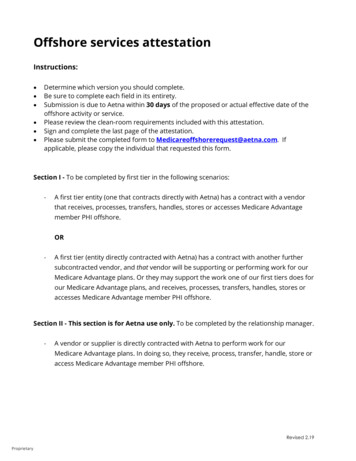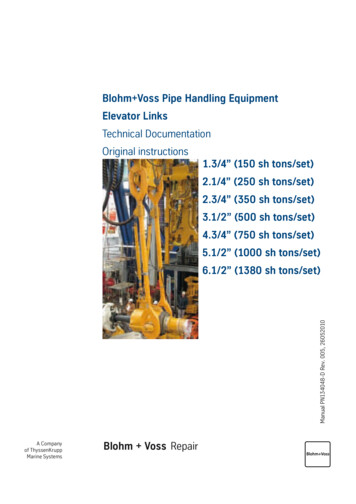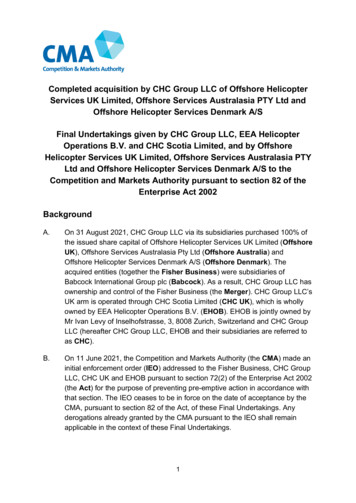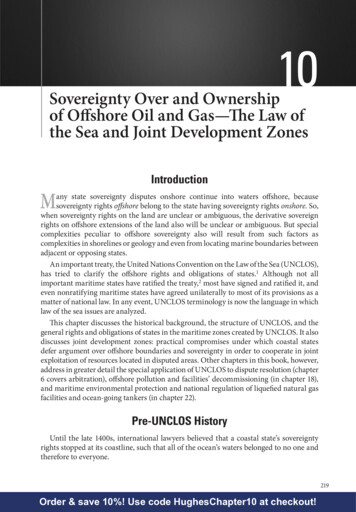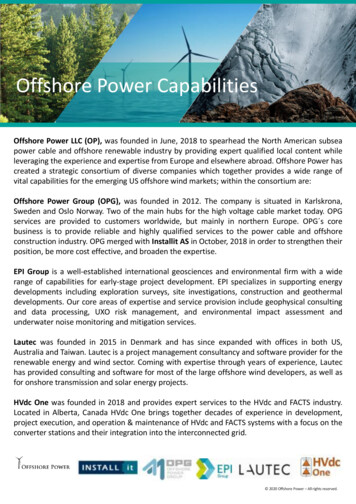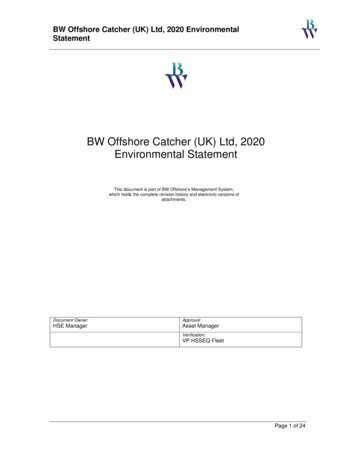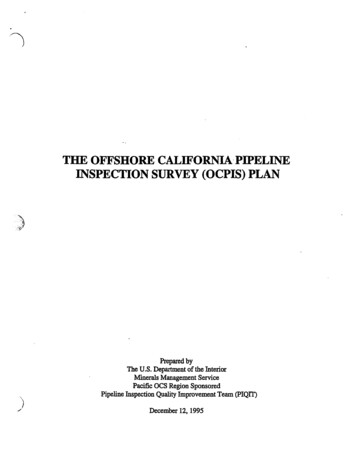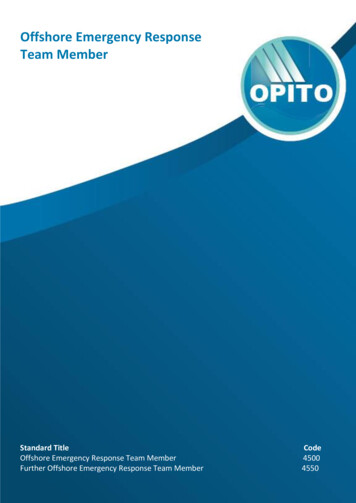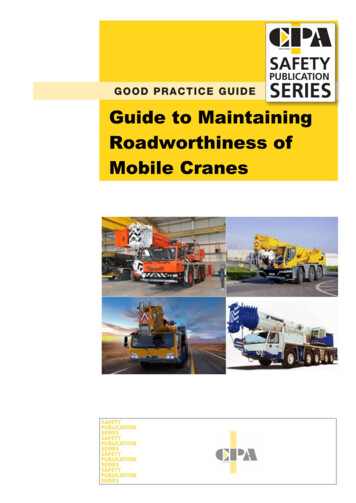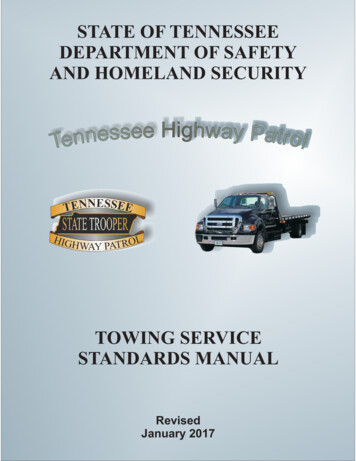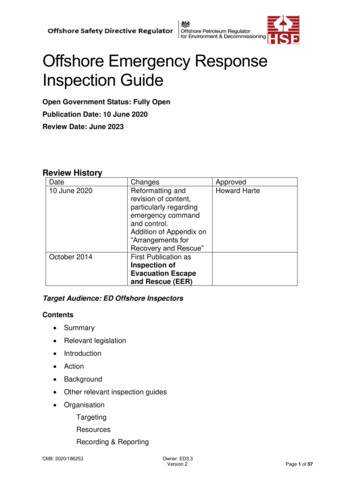
Transcription
Offshore Emergency ResponseInspection GuideOpen Government Status: Fully OpenPublication Date: 10 June 2020Review Date: June 2023Review HistoryDate10 June 2020October 2014ChangesReformatting andrevision of content,particularly regardingemergency commandand control.Addition of Appendix on“Arrangements forRecovery and Rescue”First Publication asInspection ofEvacuation Escapeand Rescue (EER)ApprovedHoward HarteTarget Audience: ED Offshore InspectorsContents Summary Relevant legislation Introduction Action Background Other relevant inspection guides OrganisationTargetingResourcesRecording & ReportingCM9: 2020/186253Owner: ED3.3Version 2Page 1 of 57
AppendicesAppendix 1: PFEER Regulation 5 assessmentAppendix 2: Preparation and arrangements for command and controlAppendix 3: Emergency response planAppendix 4: Alarms and communicationAppendix 5: Control of emergenciesAppendix 6: Access / egress routes and musteringAppendix 7: EvacuationAppendix 8: Means of escapeAppendix 9: Arrangements for recovery and rescueAppendix 10: Emergency PPE and life-saving appliancesAppendix 11: Application of the Enforcement Management Model (EMM)and dutyholder performance assessmentAppendix 12: HSE position paper: Provision of familiarisation training andinstruction for marine evacuation by TEMPSCAppendix 13: Glossary of terms, abbreviations and definitionsCM9: 2020/186253Owner: ED3.3Version 2Page 2 of 57
SummaryOffshore emergency response (ER) encompasses all the arrangements provided to minimiseand mitigate risks to the safety of offshore personnel arising from a major accident on aninstallation. ER arrangements should be designed to reduce those risks to a level that may beconsidered as low as is reasonably practicable (ALARP).For convenience of analysis and action, it is normal to consider the management of ER undertwo headings. First, there are the overarching command and control capabilities of thosecharged with the management of emergencies; and second, there are issues of team andpersonal competence, ER equipment and external support arrangements that each formvital parts of the system.This inspection guide (IG) outlines an approach to inspection of dutyholder arrangements foremergency response, and the key areas that inspectors should consider when inspecting thistopic offshore.Relevant Legislation Offshore Installations (Prevention of Fire, Explosion and Emergency Response)Regulations 1995 (PFEER) Offshore Installations (Offshore Safety Directive) (Safety Case etc.) Regulations2015 (SCR2015)IntroductionThe aim of this IG is to provide information and guidance to offshore inspectors to support thedelivery of consistent and effective safety and environmental critical element (SECE)management and assurance. It does this by highlighting key areas to be covered duringinspections, and by providing a framework for inspectors to judge compliance, assignperformance ratings and decide what enforcement action to take should they find legislativebreaches. In doing so, it complements HSE Enforcement Policy Statement (EPS) andEnforcement Management Model (EMM).References are made to technical standards and guidance that inspectors will use to formopinion for legal compliance.CM9: 2020/186253Owner: ED3.3Version 2Page 3 of 57
This guide outlines HSE’s ER topic intervention objectives during onshore and offshoreinspection. The objectives reflect specific requirements under PFEER, and the topic breaksconveniently down into ten core inspection areas as follows:1. PFEER risk assessment2. Preparation and arrangements for emergency command and control3. Emergency response planning4. Alarms and communication5. Control of emergencies6. Access/egress routes and mustering7. Arrangements for evacuation8. Means of escape9. Arrangements for recovery and rescue10. Personal Protective Equipment/Life Saving Appliances (PPE/LSA)This guidance is designed to promote a consistent approach to the inspection of theemergency response topic. An overview of each of the core areas is provided in Appendices.The success of arrangements for each of the above is key to securing effective emergencyresponse to minimise and mitigate the impact of major accidents.ActionInspection of this topic should include not only the ten core areas themselves, but also anoverview of the onshore and offshore emergency response plans to ensure a consistent andcomplete evaluation of the control measures in place.In accordance with SCR2015 there should be in place suitable performance standards (PS),verification schemes and, where necessary, written schemes of examination (WSE) for thesystems and equipment that fall within the scope of the ER topic.Success criteria for each core inspection area are contained in the Appendices. In someinstances, certain success criteria will not be applicable, and inspectors should make ajudgement regarding which are relevant in each case. If success criteria are not met, inspectorsshould assess how serious the consequences of failure to comply could be. This will informdecision making in terms of the performance ratings that they assign, and the enforcementaction they take.CM9: 2020/186253Owner: ED3.3Version 2Page 4 of 57
When carrying out inspections covered by this guidance inspectors should check the key issues against their success criteria in Appendices 1 to 10 use the generic performance descriptors in Appendix 11 to determine the appropriateperformance rating and the initial enforcement expectation to use alongside the EMMif appropriate consider how and when the issues raised during an inspection are to be closed outand recorded using the COIN Case issues tabWhere ER-related concerns are encountered during an inspection, such issues should be dealtwith by applying existing legal requirements/other relevant standards to determine what actionto take in each case according to HSE's EPS and EMM.BackgroundOffshore ER systems should be designed to mitigate the immediate aftermath of a lowfrequency event that has either escalated, or has the potential to escalate, into a majoraccident. ER systems also have relevance to other high-consequence events that might affectonly one or a small number of persons, for example, a person-overboard situation.Lord Cullen’s report of the findings of the Public Inquiry into the Piper Alpha disaster raised atotal of 106 recommendations - 41 of these relating directly to the ER topic area. The keyCullen recommendations were subsequently implemented in offshore-specific legislation.Among this legislation, the Offshore Installations (Prevention of Fire, Explosion andEmergency Response) Regulations 1995 (PFEER) specify the goals for preventative andprotective measures to manage fire and explosion, and for securing emergency response.They place the responsibility to put measures in place to achieve these goals on one person –the dutyholder. Regulation 4 places a general duty on a dutyholder to take appropriate measures witha view to protecting persons on the installation from fire and explosion; and to securingeffective emergency response.CM9: 2020/186253Owner: ED3.3Version 2Page 5 of 57
Regulation 5 requires an assessment to be undertaken to identify major accidenthazards, to evaluate related risks and to identify measures necessary to protect peopleand provide means of evacuation, escape and rescue. Regulation 6 requires the dutyholder to anticipate and be prepared for emergencies.ER preparations should include arrangements forodevelopment and assessment of an effective emergency command structure(ECS)oprovision of sufficient competent personnel to fulfil critical ER roles, andoprovision of adequate training and instruction to all personnel in appropriateactions to take in an emergency Regulation 8 requires the dutyholder to formulate a plan which documents theorganisation and arrangements for dealing with an emergency on the installation. Regulation 11 requires the dutyholder to make arrangements for giving warning in theevent of an emergency. Regulation 12 requires the dutyholder to take appropriate measures to be able to limitthe impact of an emergency. Regulation 14 requires the dutyholder to make provision of safe areas for people onthe installation to be able to muster in the event of an emergency. Regulation 15 requires the dutyholder to have in place arrangements to make a safeevacuation of the installation. Regulation 16 requires the provision of means of escape should the evacuationsystem or parts of it fail. Regulation 17 requires the dutyholder to ensure that effective means for the recoveryand rescue of people on or near the installation are in place, that these measures offera good prospect of recovery, and that ensure persons recovered / rescued are takento a place of safety.CM9: 2020/186253Owner: ED3.3Version 2Page 6 of 57
Regulation 18 requires the dutyholder to provide appropriate personal protectiveequipment (PPE) and life saving appliances (LSA) for use in the event of an emergency. Regulation 20 requires that sufficient life-saving appliances such as survival craft, liferafts, life buoys, life jackets etc. are made available for immediate use in sufficientnumbers for the number of persons on board the installation.All legislation is available to download from http://www.legislation.gov.uk/. A list of applicableHSE publications, e.g. Approved Codes of Practice (ACoP), is also provided with thesedocuments available from http://www.hse.gov.uk/An emergency response system can be considered to comprise two parts;1. Emergency command and control, and2. Emergency response systems including procedures, plant and emergencyresponse equipment.ER procedures and provisions must reflect the ability of an installation to withstand anemergency, the risks from which are required to be demonstrated as reduced to ALARP underthe safety case assessment and acceptance procedures. ER arrangements must reflect theperformance standards of the accepted safety case for mustering, for the endurance times ofegress routes and temporary refuges, and for the for evacuation, escape and recovery / rescueof personnel.Other relevant inspection guidesThere is significant overlap of the issues addressed in this IG with the those relating tocontrolling risk arising from offshore marine and aviation operations. The content of this guideshould be considered alongside that included in HSE Offshore Marine Operations andOffshore Aviation Operations IGs.Specialist AdviceFor the sake of consistency, specialist advice should be sought from ED3.3 EmergencyResponse, Marine and Aviation Operations (ERMA) discipline whenever enforcement actionis considered in relation to ER.OrganisationCM9: 2020/186253Owner: ED3.3Version 2Page 7 of 57
TargetingInspections should be planned within the timescales set out by Energy Division (ED) divisionalmanagement. Although inspections may be carried out at any installation it is particularlyimportant to carry this out where there are known issues that may affect emergency responsesuch as combined operations major work-over and construction projects sharing of recovery and rescue arrangements between installations, and changes in staffing arrangements and operating parameters such as duringdecommissioning and dismantling.It is essential to ensure that dutyholders are robust in their assessment of the implications ofthese factors, that suitable mitigations are in place and that cumulative risk factors have beenconsidered.TimingInspectors should undertake ER inspections as part of the agreed ED offshore interventionplan, when intelligence indicates intervention is necessary or when investigation due toincident is required.ResourcesED3.3 (Emergency Response, Marine and Aviation Operations (ERMA) discipline) has overallownership of this IG and takes the topic lead on inspecting ER. Resource for the undertakingof ER interventions will come from ED3.3 discipline specialist inspectors supported byinspection management team (IMT) inspectors as appropriate.Recording & ReportingThe dutyholder performance ratings should be entered on the Inspection Rating Form (IRF)tab of the relevant installation Intervention Plan Service Order. Findings should be recorded inthe normal post inspection report and letter.Further References1. Offshore Installations (Prevention of Fire and Explosion, and Emergency ResponseRegulations 1995 & ACOP L65CM9: 2020/186253Owner: ED3.3Version 2Page 8 of 57
2. Offshore Installations (Offshore Safety Directive) (Safety Case etc.) Regulations 2015& Guidance L1543. HSE Offshore Technology Report OTO 2002/021 Compatibility test protocol forlifejackets and immersion suits on offshore installation HSE Books 20024. HSE Offshore Technology Report OTO 2001/091 Inspecting and auditing themanagement of emergency response HSE Books 20015. HSE Research Report RR599 Overview of TEMPSC performance standards6. HSE Offshore Information Sheet 10/2007 Testing of TEMPSC release gear7. HSE Safety Notice 01/2006 Ensuring adequate safety during davit lifeboat drills testingand maintenance Revised 20178. HSE Offshore Information Sheet 6/2008 Ensuring the wearing of immersion suits inhelicopter evacuation or escape to sea9. HSE Offshore information sheet 12/2008 Big persons in lifeboats10. HSE Offshore Information Sheet 1/2014 Training for Emergencies on OffshoreInstallations11. Oil & Gas UK Guidelines for the Management of Emergency Response Issue 3, 201012. Oil & Gas UK Guidelines for the Management of Competence and Training inEmergency Response for Offshore Installations Issue 3, February 201013. Oil & Gas UK Emergency Response & Rescue Vessel Survey Guidelines Issue 7, May201814. Oil & Gas UK Emergency Response & Rescue Vessel Management Guidelines Issue6, May 201815. Oil & Gas UK Technical Note on Operations Assessment during Emergency Responseand Rescue Vessel Unavailability HSTN005, January 201916. Emergency Preparedness Offshore Liaison Group (EPOL) Integrated OffshoreEmergency Response Version 3, June 201917. Energy Institute Guidelines for offshore oil and gas installations that are notpermanently attended 2nd edition, November 201818. Search and rescue framework (UKSAR)CM9: 2020/186253Owner: ED3.3Version 2Page 9 of 57
APPENDIX 1: PFEER REGULATION 5 ASSESSMENT1. Fundamental RequirementThe dutyholder should have undertaken an assessment or assessments in accordance withPFEER Reg. 5; a summary of which should be in the installation’s safety case (Schedules 6 &7, SCR2015). Until an effective assessment has been undertaken, the measures required tocontrol and mitigate emergencies, and to provide effective muster, evacuation and escape,cannot be assured.2. Success CriteriaThe assessment record might be a single document, or, more likely, a series of related studiesand analyses that together form the PFEER Reg. 5 assessment. It should demonstrate thatall credible foreseeable major incident events, and their potential consequences, that couldlead to the need for emergency response have been identified; and that measures necessaryto controlling / mitigating those events are identified.Onshore inspection might include the request for and review of documentary evidence of thePFEER Reg. 5 assessment itself, or of the section of the installation safety case addressingthe assessment’s summary findings.Offshore inspection should be planned and undertaken using the information from theassessment. The output of the assessment should include the determination ofosatisfactory emergency access and egress routes,othe appropriate location of a temporary refuge and muster areas for all personnel,andothe type, number, capacity and location of evacuation and escape systems,appropriate PPE, and the arrangements for recovery and rescue. Performance standards: PSs are required for those measures to protect persons fromfire and explosion and to ensure effective evacuation, escape, recovery and recovery /rescue [PFEER Regulation 5(2)(c)]. These PSs should include measurable elementswhich demonstrate the suitable functionality, reliability, availability and survivability ofCM9: 2020/186253Owner: ED3.3Version 2Page 10 of 57
the specific SECEs to ensure effective emergency response, evacuation, escape andrecovery / rescue. There should be evidence that the assessment is reviewed as often as necessary toaccommodate changes during the life cycle of the installation.3. Key RegulationsHSWA Sections 2 and 3 – Require (as a minimum) that risks be eliminated SFAIRP (equivalentof ALARP)PFEER Reg. 5SCR2015 Reg. 16(1)(d) and (e) - L154 Para 2114. Supporting Standards/ACoP or GuidanceParagraph 57 of the PFEER Guidance L65 provides a definition of a performance standard.Paragraphs 62 to 71 of the PFEER ACoP give guidance to undertaking the assessment.SCR2015 Regulations & Guidance L154 - Schedules 6 & 7 (and Schedule 8 for dismantlingsafety cases) specify particulars to be included in the safety case, including a summary of theassessment made as required by PFEER Reg. 5.SCR2015 Guidance L154 Paragraphs 210-217 provides an indication as to the required depthof assessment and control.Oil & Gas UK Guidelines for the Management of Emergency Response for OffshoreInstallations Issue 3, 2010CM9: 2020/186253Owner: ED3.3Version 2Page 11 of 57
APPENDIX 2: PREPARATION AND ARRANGEMENTS FOR EMERGENCYCOMMAND AND CONTROL1. Fundamental RequirementPFEER Reg. 6 requires the dutyholder to establish appropriate organisation and arrangementsto deal with emergencies.In the report of the Public Inquiry into the Piper Alpha Disaster Lord Cullen was critical of theoffshore installation manager (OIM) for not exercising effective command as the disasterdeveloped. However, the Inquiry recognised the OIM had been given insufficient training inemergency command and that the installation emergency command and control systems hadnever been subject to realistic testing or assessment. There are many other historic offshoremajor incidents that provide examples of poor decision making by offshore management,under pressure during a developing major incident.Preparation of effective emergencyarrangements, and the provision of effective training for offshore managers, might haveresulted in greatly improved outcomes.The dutyholder should provide an emergency command structure (ECS), with enoughcompetent people to implement an emergency response plan (ERP) and to continue to doso, so far as is reasonably practicable, throughout an emergency. There should bearrangements for communication and coordination with the UK SAR framework.The dutyholder must also prepare and provide adequate instruction and training to ensure allpersons are sufficiently trained in appropriate action to be taken in the event of an emergency.In addition to training and competence, sufficient numbers of personnel should be inattendance for helicopter movements and lists of personnel with specific emergency dutiespublished.2. Success CriteriaThe dutyholder is required to have appropriate organisation and arrangements in place inanticipation of an emergency. These arrangements require an ECS staffed by competentpeople in sufficient numbers to be able to undertake emergency duties and operate relevantequipment.CM9: 2020/186253Owner: ED3.3Version 2Page 12 of 57
Onshore inspection might include the request for, and review of, ER training and competencyrecords.This might include evidence of the OIM and deputy OIM OPITO approved or equivalent trainingand assessment in major emergency management (with periodic revalidation as deemednecessary). There should be a well understood onshore emergency support structure whichshould be well integrated with offshore ERP. does the dutyholder have a selection policy for onshore and offshore critical personnelwho will have ECS duties that includes an assessment of leadership and installationfamiliarity as well as technical, engineering, and day-to-day operational management? has OIM / deputy successfully attended OPITO-approved major emergencymanagement (or equivalent emergency command) training and assessment courses? has OIM / deputy completed 3-yearly emergency command refresher training?Offshore inspection might include, but not necessarily be limited to, the following:Competency: Instruction / training provision to all on the installation, including offshore safetyinduction review the content and delivery of the offshore safety induction for new arrivals on theinstallation and for periodic refresher training of core crew. This should include as aminimumo alarms and action upon themo muster and alternative muster arrangementso safety tour of accommodation and external areas; to include location of escaperoutes, primary and alternative muster points, evacuation and escape facilities,and LSA review arrangements (if not provided as part of the induction itself) to ensure eachperson is familiar with all equipment they may be expected to deploy or use in anemergencyo TEMPSC – PPE/LSA requirements; safe entry and seating, and any activityexpected of personnel to support safe evacuation by TEMPSC. Familiarisationwith TEMPSC evacuation equipment and craft are crucial elements toCM9: 2020/186253Owner: ED3.3Version 2Page 13 of 57
familiarisation that can, under normal circumstances, only be provided by entryinto boats.o provision of sufficient practical training in regard to the following, whereappropriate (delivered either onshore or offshore), as is deemed to be reasonablypracticable escape chutes – selection of compatible PPE / LSA, system deploymentand use davit-launched / throw-over Life rafts – deployment and access personal descent devices (e.g. DONUTS)o immersion suits and life jackets – sizing, donning, compatibility check station bill, safety plot plans, signs and written emergency instructions areavailable, clear and legibleEmergency Command Structure (ECS) confirm that the dutyholder has provided sufficient competent people to implement theemergency response plan and provide backup/stand in for the OIM review the structure of the medical and emergency response teams and the trainingand competence records for the team members, and all those with identified specialistER roles review muster arrangements and availability of first aid, ER and communicationsequipment witness/monitor a suitable emergency exercise where possible. Dutyholders should beable to demonstrate robust systems for planning, conduct, monitoring and review of anexercise, and demonstrate recording/closeout of lessons learned. Inspection mightinclude oversight of ECR command and control exhibited by OIM and their team duringthe exercise; includingo information gathering / filteringo recognition and evaluation of emerging risko understanding of installation ER equipment and controlso competence and trainingo decision makingo incident escalationo development, communication and review of plano dealing with stress / information overloadCM9: 2020/186253Owner: ED3.3Version 2Page 14 of 57
o issue of clear instructionso teamwork and resource managemento loss of key personnelo delegation of tasksNote – The scenario chosen, and the timing and duration for the exercise / drill to be witnessed,should generally be selected by the dutyholder allowing for the operational status of theinstallation. Inspectors could fairly ask for a scenario that is representative of the currentoperational status of the installation, and that is sufficiently challenging to enable identificationof weakness(es) in the ER arrangements.Coordination with the SAR Framework of Great Britain and NIOIM and other key members of the ECS should understand relevant descriptors for, and theimplications of, declaring one of the three IAMSAR emergency phases, and coordination withthe UK SAR framework in accordance with the UK’s Integrated Offshore Emergency Response(IOER) guidance produced by the Emergency Preparedness Offshore Liaison (EPOL) Group.Installation ECS should have easy access to current contact numbers for HM Coastguard(HMC), and be prepared to provide the following critical information to the MCA when raisingan alarm emergency phase declaration who is calling? nature of the problem? confirmation of position? persons on board? what actions you are taking? what assistance do you require from HMC? weather on-scene? name and proximity of standby vessel? heli-deck serviceable? agree call back arrangements3. Key RegulationsCM9: 2020/186253Owner: ED3.3Version 2Page 15 of 57
PFEER Reg. 6(1) and (2)HSWA Sections 2 & 3Management of Health and Safety at Work Regulations 1999 (MHSWR) Reg. 134. Supporting Standards/ACoP or GuidanceParagraph 79 of the PFEER Guidance L65 refers to the training requirements that HSWAsections 2 & 3 and MHSWR Reg. 13 places on employers and goes on to explain the PFEERReg. 6 requirements placed on owner/operators.Paragraph 82 of the PFEER ACoP L65 provides a suitable standard for an ECS.Paragraph 83 of the PFEER ACoP states that those who have command responsibilities, orwho have allocated emergency duties, must be competent. Dutyholders should have a systemin place to assure themselves of the competence of the OIM and others in the command.Paragraph 76 of the PFEER Guidance define competence as having sufficient training andexperience or knowledge and other qualities.Paragraph 85 of the PFEER ACoP mentions that elements of instruction and training are alsoa vital part of general management systems, and that complying with other PFEER Regulationswill require appropriate levels of instruction and training.Paragraph 71 of the PFEER ACoP states that appropriate information, instruction and trainingon what to do in the event of an emergency is required to be provided by the dutyholder.Offshore Technology Report 2001/091 Inspecting and auditing the management of emergencyresponse provides good advice as to check lists and relevant questions sets that might assistin the evaluation of on and offshore emergency command structure (ECS).See also: Offshore Information Sheet 1/2014 Training for Emergencies on Offshore Installations Oil & Gas UK Guidelines on Management of Emergency Response Issue 3, 2010 Oil & Gas UK Guidelines on Management of Competence and Training in EmergencyResponse for Offshore Installations Issue 3, February 2010 OPITO Standards Library: Standards for Emergency Response and CompetenceCM9: 2020/186253Owner: ED3.3Version 2Page 16 of 57
Piper Alpha Public Inquiry ReportCM9: 2020/186253Owner: ED3.3Version 2Page 17 of 57
APPENDIX 3: EMERGENCY RESPONSE PLAN1. Fundamental RequirementPFEER Reg. 8 requires the dutyholder to prepare an emergency response plan, whichdocuments the organisation, arrangements and procedures for dealing with an emergency onthe installation. Dutyholders must consult with those who may become involved in emergencyresponse, including external agencies, during its preparation.2. Success CriteriaThe emergency response plan should have been developed from the findings of the PFEERReg. 5 assessment. There is no single correct structure, but whatever structure is adopted, theresult should provide a concise source of information that is readily accessible and retrievablein the event of an emergency. The plan should demonstrate that sufficient competentresources and equipment are available both onshore and offshore to implement the plan.Main elements of an emergency plan an overarching ER philosophy reference to the installation safety case - including the performance standards thatdefine the starting point for the emergency response system, and that establish theendurance, evacuation, escape and rescue times that the emergency response systemmust meet description of the emergency response organisation and emergency commandstructure, and defined emergency roles and responsibilities for designated personnelin the emergency control room (ECR)o onshore emergency support managero OIM / deputyo ECR operations officero ECR radio operatoro ECR muster coordinatoro control room operatoro muster checkerso offshore medic and first aiderso fire/emergency response team and team leadero lifeboat coxswainso helicopter landing assistants and HLOCM9: 2020/186253Owner: ED3.3Version 2Page 18 of 57
description of the alarm / internal and external communication facilities definition of a major incident; and details of foreseeable major incidents identified inrelation to the installation emergency procedures for each type of major incident – codified and set out in a userfriendly manner such as flow diagrams mustering, evacuation and escape arrangements arrangements for making all offshore personnel familiar with the part of the planrelevant to them (instruction and training arrangements, station bill, installation safetyinduction) specify the type and frequency of the training, drills and exercises necessary to ensureand maintain ER competence to ensure that all aspects of the plan can be implementedeffectively describe the mechanisms for judging the results of tests and practices againstperformance standards and for acting to address weaknesses list the emergency facilities contain an up to date emergency contact list contain proformas for emergency public address announcements reporting and notification requirementsOnshore inspection might involve the early request for onshore and offshore ERPs and areview of their content. Inspection might also include requests for demonstration as to howthe dutyholder ensures that the onshore support systems and organisations are effective e.g.do they participate in exercises?. and how do these include external organisations (police /MCA)?Offshore inspection should include, but not necessarily be limited to, the following:Emergency response plan Confirm that the emergency response plan is current, and that acontrolled copy is in place offshore. Have other stakeholders who are likely to have a role inthe implementation of the plan been consulted, e.g. HM Coastguard, other operators etc. do commu
Inspection Guide Open Government Status: Fully Open Publication Date: 10 June 2020 Review Date: June 2023 Review History Date Changes Approved . 1. Offshore Installations (Prevention of Fire and Explosion, and Emergency Response Regulations 1995 & ACOP L65 . CM9: 2020/186253 Owner: ED3.3 Version 2 Page 9 of 57 2. Offshore Installations .
